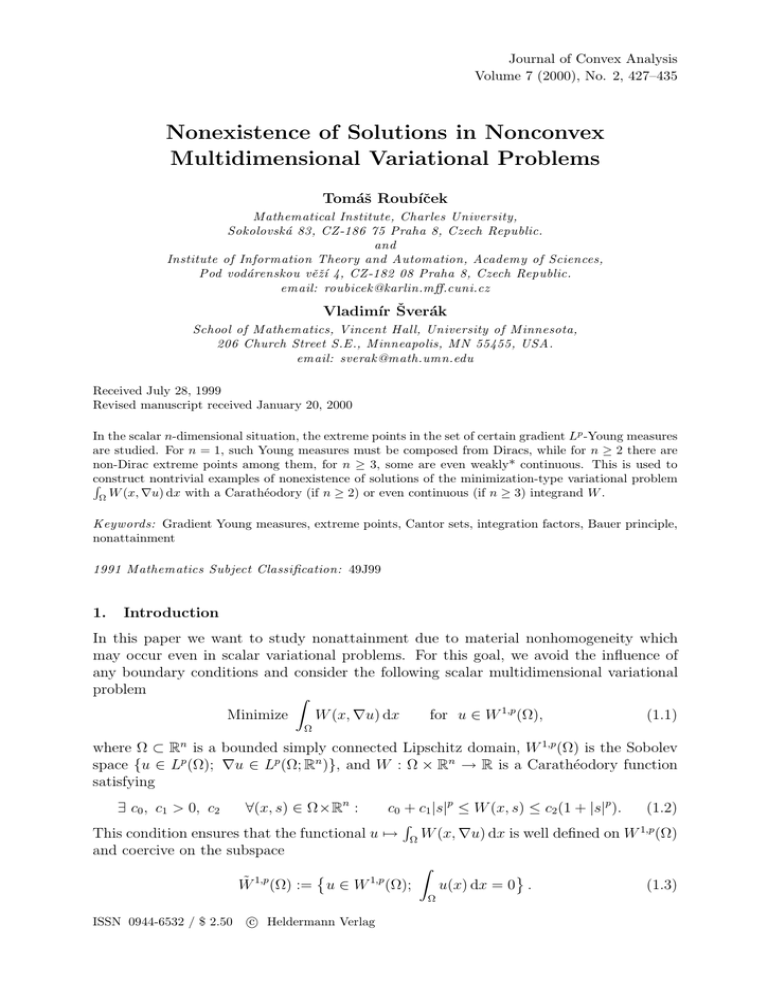Nonexistence of Solutions in Nonconvex Multidimensional Variational Problems Tom´ aˇ
advertisement

Journal of Convex Analysis
Volume 7 (2000), No. 2, 427–435
Nonexistence of Solutions in Nonconvex
Multidimensional Variational Problems
Tomáš Roubı́ček
Mathematical Institute, Charles University,
Sokolovská 83, CZ-186 75 Praha 8, Czech Republic.
and
Institute of Information Theory and Automation, Academy of Sciences,
Pod vodárenskou věžı́ 4, CZ-182 08 Praha 8, Czech Republic.
email: roubicek@karlin.mff.cuni.cz
Vladimı́r Šverák
School of Mathematics, Vincent Hall, University of Minnesota,
206 Church Street S.E., Minneapolis, MN 55455, USA.
email: sverak@math.umn.edu
Received July 28, 1999
Revised manuscript received January 20, 2000
In the scalar n-dimensional situation, the extreme points in the set of certain gradient Lp -Young measures
are studied. For n = 1, such Young measures must be composed from Diracs, while for n ≥ 2 there are
non-Dirac extreme points among them, for n ≥ 3, some are even weakly* continuous. This is used to
construct
nontrivial examples of nonexistence of solutions of the minimization-type variational problem
R
W
(x,
∇u)
dx with a Carathéodory (if n ≥ 2) or even continuous (if n ≥ 3) integrand W .
Ω
Keywords: Gradient Young measures, extreme points, Cantor sets, integration factors, Bauer principle,
nonattainment
1991 Mathematics Subject Classification: 49J99
1.
Introduction
In this paper we want to study nonattainment due to material nonhomogeneity which
may occur even in scalar variational problems. For this goal, we avoid the influence of
any boundary conditions and consider the following scalar multidimensional variational
problem
Z
W (x, ∇u) dx
Minimize
for u ∈ W 1,p (Ω),
(1.1)
Ω
where Ω ⊂ Rn is a bounded simply connected Lipschitz domain, W 1,p (Ω) is the Sobolev
space {u ∈ Lp (Ω); ∇u ∈ Lp (Ω; Rn )}, and W : Ω × Rn → R is a Carathéodory function
satisfying
c0 + c1 |s|p ≤ W (x, s) ≤ c2 (1 + |s|p ).
(1.2)
R
This condition ensures that the functional u 7→ Ω W (x, ∇u) dx is well defined on W 1,p (Ω)
and coercive on the subspace
Z
¨
©
1,p
1,p
W̃ (Ω) := u ∈ W (Ω);
u(x) dx = 0 .
(1.3)
∃ c0 , c1 > 0, c2
∀(x, s) ∈ Ω×Rn :
Ω
ISSN 0944-6532 / $ 2.50
c Heldermann Verlag
­
428
T. Roubı́ček, V. Šverák / Nonexistence of solutions in nonconvex problems
We are especially interested in the case when W (x, ·) is nonconvex. Such problems often
do not have any solution; we then speak about nonattainment while in the converse case
we speak about attainment. For n = 1 the attainment is quite typical; in fact, it holds even
for Dirichlet boundary conditions and u vector-valued. For this sorts of results we refer
to Aubert and Tahraoui [1, 2], Cellina and Colombo [7], Mariconda [14], Ornelas [16] and
Raymond [18, 21]. This effect has also been known for a long time in context of optimal
control theory, see Cesari [8]. However, contrary to the one-dimensional case, for n ≥ 2 the
Dirichlet boundary conditions may create very easily the nonattainment effect even if W is
independent of x, though in special situations the attainment effect can occur even there.
This spatially homogeneous case has been studied by Bauman and Phillips [5], Chipot
[9], Cellina [6], Flores [10], Friesecke [11], Marcellini [13], Mascolo and Schianchi [15], and
Raymond [19, 20]. To avoid rather trivial situations for nonattainment, we thus did not
involve Dirichlet boundary conditions into (1.1) but allowed nonhomogeneous situations,
i.e. W depends on x. For the relations with Dirichlet conditions in the homogeneous case
we refer to [11, Theorem 1].
It seems that in our scalar case the attainment is closely related through the Bauer
extremal principle [4] with the structure of extreme points of the set of admissible pairs
(u, ν) for the so-called relaxed problem, as pointed out by Balder [3] in a more general
context; here ν stands for a Young measure related with u by (2.3) below. We will
address this question in Section 2, showing that attainment appears if all extreme points
are trivial while existence of nontrivial “uniformly properÔ (in the sense of (2.9) below)
extreme points allows us to construct examples of (1.1) with non-attainment relying on
the x-dependence of W . Thus, our aim is to construct the nontrivial extreme points in
case n ≥ 2. More precisely, in Section 3 we will do this for n ≥ 2 by highly oscillatory
manner, using Cantor sets, which result to W a mere Carathéodory function, while in
Section 4 we will show it for n ≥ 3 by vector fields with no nontrivial integration factors,
which leads to W jointly continuous.
2.
Extreme gradient Young measures
Since W does not depend on u but only on ∇u, we can replace W 1,p (Ω) in (1.1) by
W̃ 1,p (Ω). Then every solution of such modified problem solves (1.1)R and conversely every
solution to (1.1) can be shifted by a suitable constant to satisfy Ω udx = 0, obtaining
thus a solution of the modified problem.
Then a natural relaxation of the variational problem (1.1) takes the form
Z Z
Minimize
W (x, s)νx (ds)dx
Ω Rn
Z
subject to ∇u(x) =
s νx (ds) for a.a. x ∈ Ω,
n
R
u ∈ W̃ 1,p (Ω), ν ∈ Y p (Ω; Rn ),
where Y p (Ω; Rn ) is the set of the so-called Lp -Young measures defined by
¨
Y p (Ω; Rn ) := ν : x 7→ νx : Ω → rca(Rn ) weakly measurable;
νx is a probability measure for a.a. x ∈ Ω,
Z Z
©
|s|p νx (ds)dx < +∞
Ω
Rn
(2.1)
(2.2)
T. Roubı́ček, V. Šverák / Nonexistence of solutions in nonconvex problems
429
where rca(Rm ) ∼
= C0 (Rm )∗ stands for the set of the Radon measures on Rm .
Proposition 2.1 (Kinderlehrer-Pedregal [12]). Let (1.2) be valid for p > 1. Then
inf (1.1) = inf (2.1) and (2.1) always has a solution.
In fact, [12] deals with even a much more complicated vectorial situation. We refer also
to monographs [17, Theorems 4.4 and 8.7] and [22, Proposition 5.2.6].
If (u, ν) is a solution to (2.1) and ν is a Dirac mass a.e. on Ω, then obviously νx = δ∇u(x)
for a.a. x ∈ Ω with δs ∈ rca(Rn ) denoting the Dirac mass supported at s ∈ Rn . Then
Proposition 2.1 implies that u solves the original problem (1.1).
The problem of nonattainment in (1.1) will be shown to have an intimate relation with
the structure of extreme points of the convex set of the admissible pairs for (2.1), i.e. the
set
º
»
Z
1,p
p
n
Dad := (u, ν) ∈ W̃ (Ω)×Y (Ω; R ); ∇u(x) =
s νx (ds) for a.a. x ∈ Ω .
(2.3)
Rn
Note that, for any (u, ν) ∈ Dad , the Lp -Young measure ν satisfies
Z
¡
curl
s νx (ds) = 0.
(2.4)
Rn
Let us remind that (u, ν) ∈ Dad is called an extreme point if
∀(u1 , ν1 ), (u2 , ν2 ) ∈ Dad :
1
1
(u1 , ν1 ) + (u2 , ν2 ) = (u, ν) ⇒ (u1 , ν1 ) = (u2 , ν2 ).
2
2
(2.5)
Note that, as u ∈ W̃ 1,p (Ω) is determined uniquely by ν, the pair (u, ν) is an extreme point
in Dad if and only if ν is an extreme point in G p (Ω; Rn ) := {ν; ∃u : (u, ν) ∈ Dad }, i.e.
in the set of the Rso-called gradient Lp -Young measures whose underlying displacement u
has the average Ω udx zero. The interesting question is whether all extreme points of
G p (Ω; Rn ) are composed from Dirac masses a.e. on Ω, i.e.
³
²
ν1 + ν2
p
n
= ν ⇒ ν1 = ν2
ν1 , ν2 ∈ G (Ω; R ) &
2
(2.6)
⇒ νx is a Dirac mass for a.a. x ∈ Ω.
Proposition 2.2. Let (1.2) be valid for p > 1 and let (2.6) hold. Then (1.1) has a
solution.
Sketch of the proof. By the coercivity (1.2), all minimizing sequences {uk } for (1.1)
must eventually satisfy k∇uk kLp (Ω;Rn ) ≤ R for R large enough, e.g. for R > (meas(Ω)(c2 −
c0 )/c1 )1/p with c0 , c1 and c2 from (1.2). Then the problem (2.1) has the Rsame
R solution
as the minimization problem of the affine continuous functional (u, ν) 7→ Ω Rn W (x, s)
νx (ds)dx over the convex weakly* compact set
(
)
²Z Z
³
1/p
%
Dad
:=
p
(u, ν) ∈ Dad ;
|s| νx (ds)dx
Ω
Rn
≤%
(2.7)
430
T. Roubı́ček, V. Šverák / Nonexistence of solutions in nonconvex problems
provided % ≥ R. Using this fact for % = 21/p R, we can see that there is at least one solution
21/p R
(u, ν) of this problem (and thus also of (2.1)) which is an extreme point in Dad
; this
follows from Bauer’s extremal principle [4] which says that a concave continuous functional
on a convex compact set attains its minimum in an extreme point of this set. Yet, every
R
R
solution to (2.1) must lie in Dad
, so it is also true that (u, ν) ∈ Dad
. Then (u, ν) is an
1
1
extreme point even in Dad because 2 (u1 , ν1 ) + 2 (u2 , ν2 ) = (u, ν) for (u1 , ν1 ) ∈ Dad and
1/p
2 R
(u2 , ν2 ) ∈ Dad implies automatically (u1 , ν1 ) ∈ Dad
due to the estimate
Z Z
Z Z
Z Z
p
p
|s| ν1,x (ds)dx =
|s| (2νx − ν2,x )(ds)dx ≤ 2
|s|p νx (ds)dx ≤ 2Rp ,
Ω
Rn
Ω
Rn
Ω
Rn
1/p
2 R
and by symmetry also (u2 , ν2 ) ∈ Dad
. Then (2.6) implies that ν is a Dirac mass for
a.a. x ∈ Ω, so that necessarily νx = δ∇u(x) and u solves (1.1).
Proposition 2.3. Let n = 1. Then the condition (2.6) actually holds.
In case n = 1, the equality constraints in (2.3), i.e. ∇u(x) =
RSketch of the proof.
R
s
ν
(ds)
and
u(x)dx
= 0, do not represent any actual restriction in the sense that
x
Rn
Ω
p
p
Y (Ω; R) = G (Ω; R). Yet the extreme points in Y p (Ω; R) have just the structure ν =
{δy(x) }x∈Ω with y ∈ Lp (Ω), see [22, Proposition 3.2.11].
Therefore, Propositions 2.2 and 2.3 immediately implies the attainment in (1.1) for n = 1.
The converse implication, which may come into considerations for n ≥ 2, i.e. whether
failure of (2.6) implies nonattainment in (1.1), is not completely clear. Nevertheless, some
“non-DiracÔ extreme points of G p (Ω; Rn ) can give an immediate hint for a counter-example
of attainment in (1.1) relying on a uniqueness (at least “locallyÔ, cf. (2.14) below) of the
solution to (2.1) being just this extreme point. Let us first realize that any extreme point
ν of G p (Ω; Rn ) can be decomposed as a pointwise convex combination of at most n + 1
terms:
for a.a. x ∈ Ω ∃ m(x) ∈ N, m(x) ≤ n + 1, ∃ ai (x) ∈ [0, 1], ∃ yi (x) ∈ Rn :
m(x)
m(x)
{yi (x)}i=1
is an m(x)-dimensional simplex & νx =
X
ai (x)δyi (x) , (2.8)
i=1
otherwise one can easily construct mutually different ν1 , ν2 ∈ Y p (Ω; Rn ) with the same
barycenter as ν, and therefore ν1 , ν2 ∈ G p (Ω; Rn ).
In view of (2.2), m can be considered measurable and, for all i = 1, ..., m(x), also (ai , yi )
can be considered defined on a measurable set and itself to be measurable.
Proposition 2.4. Let (u, ν) ∈ Dad be an extreme point of Dad such that (2.8) holds with
∃ε > 0 ∀x ∈ Ω (a.a.) ∀i = 1, ..., m(x) :
ai (x) ≥ ε .
(2.9)
If m(x) ≥ 2 for x from a non-zero measure set, then the problem (1.1) does not have any
solution if the “energy densityÔ W is taken to be
W (x, s) :=
min
i=1,...,m(x)
|s − yi (x)|p .
(2.10)
T. Roubı́ček, V. Šverák / Nonexistence of solutions in nonconvex problems
431
Proof. First, (u, ν) in question solves the relaxed problem (2.1) with W from (2.10) beR R
R P
cause obviously Ω Rn W (x, s)νx (ds)dx = Ω m(x)
i=1 ai (x)W (x, yi (x))dx = 0 ≤ min (2.1)
as 0 ≤ W and W (x, yi (x)) ≡ 0. In particular, min (2.1) = 0.
We will prove that this solution is unique. Suppose that (u1 , ν1 ) ∈ Dad is another solution
m(x)
to (2.1). As min (2.1) = 0, ν1,x must be supported on the finite set {yi (x)}i=1 , i.e.
m(x)
∃ a1,i (x) ∈ [0, 1] :
ν1,x =
X
a1,i (x)δyi (x)
(2.11)
i=1
for a.a. x ∈ Ω. As ν1 is weakly measurable, a1,i can be assumed measurable, too. For a
parameter α ∈ R, take (uα , να ) given by
m(x)
uα := αu1 + (1 − α)u ,
να,x :=
X
aα,i (x)δyi (x) ,
(2.12)
i=1
aα,i (x) := αa1,i (x) + (1 − α)ai (x) .
Obviously, L := {(uα , να ); α ∈ R} is just the line going through (u, ν) and (u1 , ν1 ). We
then have
Z
Z
Z
uα dx = α u1 dx + (1 − α) udx = 0
(2.13)
Ω
Ω
Ω
and also, for a.a. x ∈ Ω,
Z
s να,x (ds) =
Rn
m(x)
m(x)
X
X
aα,i (x)yi (x) = α
i=1
=α
Z
m(x)
a1,i (x)yi (x) + (1 − α)
i=1
s ν1,x (ds) + (1 − α)
Rn
Z
X
ai (x)yi (x)
i=1
s ν1 (ds) = α∇u1 (x) + (1 − α)∇u(x) = ∇uα (x).
Rn
Hence we can see that (uα , να ) will belong to Dad provided να ∈ Y p (Ω; Rn ). As always
m(x)
m(x)
X
X
i=1
aα,i (x) = α
i=1
m(x)
a1,i (x) + (1 − α)
X
ai (x) = α + (1 − α) = 1,
i=1
it suffices aα,i (x) ∈ [0, 1]. This is valid for any α ∈ [−ε/(1 − ε), 1] because of (2.12)
and of the assumptions ai (x) ∈ [ε, 1] and a1,i (x) ∈ [0, 1]. However, this shows that
(u1 , ν1 ) = (u, ν) otherwise (u, ν) = (u0 , ν0 ) would lie in the interior of the segment Dad ∩ L
and could not thus be an extreme point in Dad .
Suppose for a moment that (1.1) has a solution, say w ∈ W 1,p (Ω). Without loss of
generality we may suppose that w ∈ W̃ 1,p (Ω). Then (w, δ∇w ) solves (2.1). As we supposed
m(x)
{yi (x)}i=1 not identically a singleton (recall that m(x) ≥ 2 for x from a non-zero measure
m(x)
set, {yi (x)}i=1 is an m(x)-dimensional simplex, and ai are nonvanishing), ν from (2.8)
must differ from δ∇w . Thus we can see that (2.1) would have two solutions, a contradiction.
432
T. Roubı́ček, V. Šverák / Nonexistence of solutions in nonconvex problems
Hence, to construct examples of nonattainment in (1.1), we will seek extreme points in
Dad of the form (2.8) which are not identically Diracs and whose coefficients ai are away
from zero, as assumed in (2.9). Let us still remark that one can construct other examples
than (2.10), not relying on uniqueness of the solution to (2.1); assuming |yi | bounded by r,
it suffices to take a simply connected subdomain Ω0 of Ω such that meas({x ∈ Ω0 ; m(x) ≥
2}) > 0, and then modify (2.10) as follows:
(
mini=1,...,m(x) |s − yi (x)|p for x ∈ Ω0 ,
(2.14)
W (x, s) :=
max(|s|p , r)
for x ∈ Ω \ Ω0 .
The modification of the proof of Proposition 2.4 is simple, and the solution (u, ν) to
(2.1) is not unique because νx can be supported arbitrarily in the ball of the radius r if
x ∈ Ω \ Ω0 .
3.
The case n ≥ 2
We will construct explicitly an extreme pair (u, ν) with ν satisfying the assumptions of
Proposition 2.4. For this, we take n Cantor sets K1 , K2 , ..., Kn ⊂ R having a positive
Lebesgue measure and positioned in such a way that K := K1 × K2 × ... × Kn ⊂ Ω ⊂ Rn .
Proposition 3.1. Let y ∈ L∞ (Ω; Rn ) be arbitrary, n ≥ 2. Then the pair (u, ν) with
(
1
δy(x) + 12 δ−y(x) if x ∈ K := K1 × K2 × ... × Kn ,
u(x) = 0 , νx := 2
(3.1)
δ0
if x ∈ Ω \ K,
forms an extreme point in Dad .
Proof. Take (u1 , ν1 ) ∈ Dad and (u2 , ν2 ) ∈ Dad , and assume that
1
1
u1 + u2 = u and
2
2
1
1
ν1 + ν2 = ν.
2
2
(3.2)
The latter equality implies, in particular, that ν1,x = ν2,x = δ0 for x ∈ Ω \ K, which is
an open, connected (if n ≥ 2 as supposed), and dense subset of Rn . For x ∈ K, both
ν1,x and ν2,x must be supported on the set {y(x), −y(x)} which is supposed bounded in
Rn uniformly with respect to x because y ∈ L∞ (Ω; Rn ). Therefore, both u1 and u2 have
a bounded gradient almost everywhere, and thus they are (even Lipschitz) continuous.
As ∇u1 (x) = ∇u2 (x) = 0 for x ranging a dense, open, connected subset of Ω, both u1
and
u2 must be constant everywhere on Ω. Since u1 , u2 ∈ W̃ 1,p (Ω) so that obviously
R
(u − u2 )dx = 0 we have u1 = 0 = u2 .
Ω 1
Then ∇u1 = 0 = ∇u2 a.e. on Ω, which fixes the barycenter of ν1,x and ν2,x . As both
these measures are at most two-atomic, we got inevitably ν1,x = νx = ν2,x for a.a. x ∈ Ω.
Altogether, we proved that (u1 , ν1 ) = (u2 , ν2 ), which just means by the definition (2.3)
that (u, ν) is indeed an extreme point in Dad .
As mentioned, we will consider each K1 , K2 , ... Kn having a positive one-dimensional
Lebesgue measure and the vector field y not vanishing on their product K. Then Proposition 3.1 gives an example of an extreme point (u, ν) ∈ Dad with ν not a Dirac mass a.e.
T. Roubı́ček, V. Šverák / Nonexistence of solutions in nonconvex problems
433
on Ω. More precisely, this ν satisfies the assumptions in Proposition 2.4 with ε = 1/2, so
that there is the nonattainment in (1.1) provided the energy density W is defined as
(
min(|s − y(x)|p , |s + y(x)|p ) if x ∈ K := K1 × K2 × ... × Kn ,
(3.3)
W (x, s) :=
|s|p
if x ∈ Ω \ K.
As y is measurable, W is a Carathéodory function. Moreover, as y is essentially bounded,
(1.2) is satisfied, too.
4.
The case n ≥ 3
The construction from Section 3 yields an example of an extreme gradient Young measure
ν ∈ G p (Ω; Rn ) which is not a Dirac mass a.e. but x 7→ νx oscillates widely. Now we will
use a more sophisticated construction to show explicitly an extreme ν ∈ G p (Ω; Rn ) such
that νx is not a Dirac mass a.e. and even x 7→ νx : Ω → rca(Rn ) is weakly* continuous.
We will consider only n = 3, the case n ≥ 4 being then similar.
For this, we will use a vector field y ∈ C ∞ (Ω̄; R3 ) which does not have an integration
factor, which means that there is no λ ∈ L∞ (Ω) nontrivial (i.e. not identically zero) such
that curl(λy) = 0 in the sense of distributions.
Lemma 4.1. If y ∈ C ∞ (Ω̄; R3 ) satisfies y · curl(y) 6= 0 a.e. on Ω, then this field has no
measurable nontrivial integration factor.
Proof. Since curl(λy) = λ curl(y) + ∇λ × y, it holds in the classical sense that
y · curl(λy) = y · (λ curl(y)) + y · (∇λ × y) = λ(y · curl(y))
(4.1)
at least for smooth λ’s. This implies y·curl(λy) = λ(y·curl(y)) in the sense of distributions
even for any λ ∈ L∞ (Ω) because one can make a limit passage with smooth λ’s in the
integral identity
Z
Z
λy · curl(yv)dx =
Ω
λ(y · curl(y))vdx
(4.2)
Ω
for any fixed v ∈ C ∞ (Ω) compactly supported. Thus, if curl(λy) = 0 in the sense of
distributions, we get λ(y · curl(y)) = 0 in the sense of distributions. Assuming y · curl(y) 6=
0, one gets λ = 0 in the sense of distributions, hence in L∞ (Ω), too.
Proposition 4.2. Let y ∈ C ∞ (Ω̄; R3 ) and y · curl(y) 6= 0 hold a.e. on Ω. Then the pair
(u, ν) with
1
1
u(x) = 0 , νx := δy(x) + δ−y(x)
(4.3)
2
2
forms an extreme point in Dad .
Proof. Take (u1 , ν1 ) ∈ Dad and (u2 , ν2 ) ∈ Dad , and assume (3.2). This, together with
the fact that both ν1,x and ν2,x are probability measures, implies that necessarily
²
³
²
³
1
1
ν1,x =
+ ε(x) δy(x) +
− ε(x) δ−y(x) ,
(4.4a)
2
2
²
³
²
³
1
1
− ε(x) δy(x) +
+ ε(x) δ−y(x)
(4.4b)
ν2,x =
2
2
434
T. Roubı́ček, V. Šverák / Nonexistence of solutions in nonconvex problems
1 1
∞
Rfor some ε ∈ L (Ω) such that ε(x) ∈ [− 2 , 2 ]. Moreover (u1 , ν1 ) ∈ Dad implies ∇u1 (x) =
s ν1,x (ds) =: y1 (x) so that the vector field y1 is rotation free, i.e. curl(y1 ) = 0. However,
R3
from (4.4) it follows that y1 = 2εy, so that 2ε is a measurable integration factor for the
vector field y. Yet, by RLemma 4.1, ε = 0 so that ν1 = ν and also ∇u1 = y1 = 2εy = 0. As
u1 ∈ W̃ 1,p (Ω) so that Ω u1 dx = 0, we eventually obtain u1 = 0. Altogether, we obtained
(u1 , ν1 ) = (u, ν), and analogously (u2 , ν2 ) = (u, ν). Thus (u, ν) is an extreme point in
Dad , as claimed.
Let us remark that the field y(x1 , x2 , x3 ) = (0, x1 , 1) is an elementary example for a smooth
y satisfying y · curl(y) 6= 0 as assumed in Proposition 4.2. We thus get an example for
nonattainment in (1.1) provided W is defined as
W (x, s) := min(|s − y(x)|p , |s + y(x)|p ).
(4.5)
As y is now continuous on Ω̄, W is even jointly continuous and obviously (1.2) is again
satisfied.
Acknowledgements. This research has been carried out during T.R.’s stays at the University
of Minnesota, partly supported also by the grant A 107 5707 (GA AV ČR). Also, comments of
anonymous referees were very appreciated.
References
[1] G. Aubert, R. Tahraoui: Théorèmes d’existence pour des problèmes du calcul des variations
RL
RL
du type Inf 0 f (x, u0 (x)dx et Inf 0 f (x, u(x)u0 (x))dx, J. Diff. Equations 33 (1979) 1–15.
[2] G. Aubert, R. Tahraoui: Young measures and relaxation of functionals for integrands
f (x, u(x), u0 (x)), Diff. Int. Equations 9 (1996) 27–43.
[3] E. J. Balder: New existence results for optimal controls in the absence of convexity: the
importance of extremality, SIAM J. Control Anal. 32 (1994) 890–916.
[4] H. Bauer: Minimalstellen von Funktionen und Extremalpunkte, Archiv d. Math. 9 (1958)
389–393, Archiv d. Math. 11 (1960) 200–205.
[5] P. Bauman, D. Phillips: A nonconvex variational problem related to change of phase, Appl.
Math. Optim. 21 (1990) 113–138.
[6] A. Cellina: On minima of a functional of the gradient, Nonlinear Analysis, Th. Meth. Appl.
20 (1993) 337–341, 343–347.
[7] A. Cellina, G. Colombo: On a classical problem of the calculus of variations without convexity assumptions, Annales Inst. H. Poincaré, Anal. Nonlin. 7 (1990) 97–106.
[8] L. Cesari: An existence theorem without convexity conditions, SIAM J. Control 12 (1974)
319–331.
[9] M. Chipot: Numerical analysis of oscillations in nonconvex problems, Numer. Math. 59
(1991) 747–767.
[10] F. Flores: The lack of lower semicontinuity and nonexistence of minimizers, Nonlinear Anal.,
Th. Meth. Appl. 23 (1994) 143–153.
[11] G. Friesecke: A necessary and sufficient conditions for nonattainment and formation of microstructure almost everywhere in scalar variational problems, Proc. Royal Soc. Edinburgh
124 A (1994) 437–471.
T. Roubı́ček, V. Šverák / Nonexistence of solutions in nonconvex problems
435
[12] D. Kinderlehrer, P. Pedregal: Gradient Young measures generated by sequences in Sobolev
spaces, J. Geom. Anal. 4 (1994) 59–90.
[13] P. Marcellini: Some problems of existence, uniqueness and regularity in the calculus of
variations, in: World Congress of Nonlin. Analysts ’92 (ed. V. Lakshmikantham), W. de
Gruyter, Berlin (1996) 2089–2095.
[14] C. Mariconda: On a parametric problem of the calculus of variations without convexity
assumptions, J. Math. Anal. Appl. 170 (1992) 291–297.
[15] E. Mascolo, R. Schianchi: Existence theorem for nonconvex problems, J. Math. Pures Appl.
62 (1983) 349–359.
[16] A. Ornelas: Existence of scalar minimizers for nonconvex simple integrals of sum type, J.
Math. Anal. Appl. 221 (1998) 559–573.
[17] P. Pedregal: Parametrized Measures and Variational Principles, Birkhäuser, Basel, 1997.
[18] J.-P. Raymond: Conditions nécessaires et suffisantes d’existence de solutions en calcul des
variations, Annales Inst. H. Poincaré, Anal. Nonlin. 4 (1987) 169–202.
[19] J.-P. Raymond: Théorème d’existence pour des problèmes variationnels non convexes, Proc.
Royal Soc. Edinburgh 107 A (1987) 43–64.
[20] J.-P. Raymond: An anti-plane shear problem, J. Elasticity 33 (1993) 213–231.
[21] J.-P. Raymond: Existence and uniqueness results for minimization problems with nonconvex functionals, J. Optim. Theory Appl. 82 (1994) 571–592.
[22] T. Roubı́ček: Relaxation in Optimization Theory and Variational Calculus, W. de Gruyter,
Berlin, 1997.






